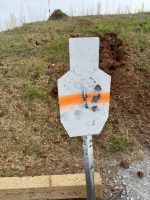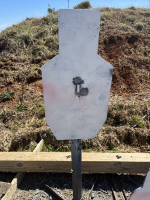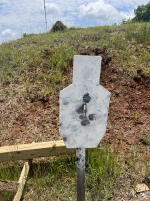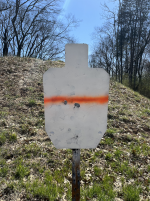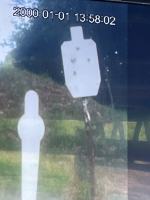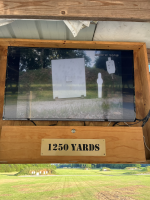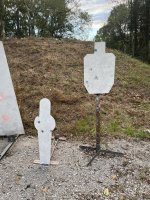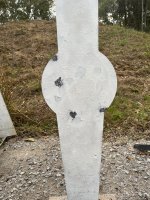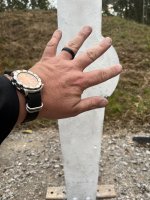For the experts on here - do you guys figure out what COAL your chamber likes first, and then test powder loads at that seating depth, or do you pick your powder load and then test varying seating depths to dial it in? It doesn't seem like you can work on both at the same time - or can you?
Join the Hide community
Get access to live stream, lessons, the post exchange, and chat with other snipers.
Register
Download Gravity Ballistics
Get help to accurately calculate and scope your sniper rifle using real shooting data.

Install the app
How to install the app on iOS
Follow along with the video below to see how to install our site as a web app on your home screen.
Note: This feature may not be available in some browsers.
You are using an out of date browser. It may not display this or other websites correctly.
You should upgrade or use an alternative browser.
You should upgrade or use an alternative browser.
Load Development - Process
- Thread starter rlownote
- Start date
I do a coarse powder, seating depth, refine the powder and confirm.
I start with bullet up against the rifling and find max charge by looking for pressure signs. Then I back off the charge some, check velocity. Then I start seating deeper and deeper. Once that gets to where I am happy with accuracy, I run another 20 or so at that charge/depth across the chrono. Usually am finished with load development in 20-40 rounds, then the extra across the chronograph.
And mine usually take 100-150. The difference being that aftermath is fine with what he sees if it meets his standards, I want to see if I’m missing anything that may be a bit better. Usually my first impressions are correct and aftermaths method saves a trip or two. Once in a while I see that there was more to be gained with further testing, at least if you’re shooting paper.
And then there is the third party that says load development at all is a crock of shit. I call them idiots.
And then there is the third party that says load development at all is a crock of shit. I call them idiots.
This is 100% true. Especially about the idiots.And mine usually take 100-150. The difference being that aftermath is fine with what he sees if it meets his standards, I want to see if I’m missing anything that may be a bit better. Usually my first impressions are correct and aftermaths method saves a trip or two. Once in a while I see that there was more to be gained with further testing, at least if you’re shooting paper.
And then there is the third party that says load development at all is a crock of shit. I call them idiots.
I use to go a bit farther and still do once in a while.
By that, I mean, once I have that good precision at the initial charge and seating depth, I would then try more powder at this seating depth. This may seem counter to what I said before because I had already found max charge...but when you move that bullet away from the rifling, the pressure will go down. Since I can't actually measure, I will go by what I have read and say that just a couple of thousandths makes a significant reduction in pressure...and velocity. So, I have tried pushing that back up by adding some powder. Thing is, maybe 80-90% of the time, accuracy falls off. I'd need to work on a new seating depth.
Just my opinion, maybe a little educated but 100% no proof, I think that a certain bullet (and the other variables..barrel, brass, primer, chamber) work best at a certain PRESSURE. I will leave it there.
Rather than just say something cute like "it depends...."... let me just throw out some food for thought...
Magazine, or single load? (Semi/Full Auto?)
Known bullet and chamber combination. or totally unknown?
Sporting carry rifle, or match gun?
Secant, tangent, or hybrid?
You see my point? I am not a good writer and it is hard to convey why the context for your question is very important. Without context, your answers will run all over the map.
Sometimes, jam is appropriate and we have a rough charge in mind based on several barrels and tribal knowledge from our fellow competitors. In that context, we start with seating depth and then cycle back and forth to charge and verify that first seating depth.
In other context, we need jump in order to eject a loaded round, so we may start with powder charge and jump 0.020", then when we find a good charge we circle back to investigate jump.
There is no single answer to this because there is no single context.
Magazine, or single load? (Semi/Full Auto?)
Known bullet and chamber combination. or totally unknown?
Sporting carry rifle, or match gun?
Secant, tangent, or hybrid?
You see my point? I am not a good writer and it is hard to convey why the context for your question is very important. Without context, your answers will run all over the map.
Sometimes, jam is appropriate and we have a rough charge in mind based on several barrels and tribal knowledge from our fellow competitors. In that context, we start with seating depth and then cycle back and forth to charge and verify that first seating depth.
In other context, we need jump in order to eject a loaded round, so we may start with powder charge and jump 0.020", then when we find a good charge we circle back to investigate jump.
There is no single answer to this because there is no single context.
My favorite idiots are the ones who say "seating depth doesn't matter, just load to mag length". Right now for fun I am testing a bunch of diff stuff at diff seating depths and filming it to show the difference. I may share it if it doesn't end up seeming boring.And mine usually take 100-150. The difference being that aftermath is fine with what he sees if it meets his standards, I want to see if I’m missing anything that may be a bit better. Usually my first impressions are correct and aftermaths method saves a trip or two. Once in a while I see that there was more to be gained with further testing, at least if you’re shooting paper.
And then there is the third party that says load development at all is a crock of shit. I call them idiots.
I don't worry about MAX charge. I start usually somewhere around a medium charge and if the accuracy is good I will use that charge (so long as the velocity is good, for me I am not trying to set speed records or burn out a barrel as fast as possible). Heck for my 6BR I am at 28.9 gr of varget W/ 105 gr bullets and getting 2800 fps and a little more. That is plenty fast enough for me and get 1/2 moa or better.
After I get a charge weight I am happy with I will try seating depth (I start @ .010 off the lands). Then after I find a seating depth that seems to do ok, I will load more and shoot 5 shot groups with that to confirm and after 20-30 rds if it's good I call it good. If those 20-30 didn't confirm, I try some other stuff.
I have a 6.5x47 that really doesn't like 123gr bullets for some reason but it likes 140s. I am planning on trying some more 123s at some point though because I have a few thousand of them.
There's some great stuff here. My first forray into reloading is 300 BLK. I know this isn't a precision round, but I wanted to develop the "best" 30 cal subsonic round I could - trying for 1 moa at 100yds. I've found out that it isn't easy, but it's worth pursuing - at least for me. Next up it's 6.5 CM from a bolt action. This is where all this will really matter, I think.
@tinker,I guess I'm one of those idiots to some extent but seating depth does matter. But to me these posts often miss an important part of the question, especially if the post is from someone new to precision reloading. The OP didn't say what he was shooting. There is an enormous difference between a custom rifle with a Match Grade chamber and say a Remington 700 308 with freebore that would preclude ever getting near 35/1000 off the lands or something in between.My favorite idiots are the ones who say "seating depth doesn't matter, just load to mag length". Right now for fun I am testing a bunch of diff stuff at diff seating depths and filming it to show the difference. I may share it if it doesn't end up seeming boring.
I don't worry about MAX charge. I start usually somewhere around a medium charge and if the accuracy is good I will use that charge (so long as the velocity is good, for me I am not trying to set speed records or burn out a barrel as fast as possible). Heck for my 6BR I am at 28.9 gr of varget W/ 105 gr bullets and getting 2800 fps and a little more. That is plenty fast enough for me and get 1/2 moa or better.
After I get a charge weight I am happy with I will try seating depth (I start @ .010 off the lands). Then after I find a seating depth that seems to do ok, I will load more and shoot 5 shot groups with that to confirm and after 20-30 rds if it's good I call it good. If those 20-30 didn't confirm, I try some other stuff.
I have a 6.5x47 that really doesn't like 123gr bullets for some reason but it likes 140s. I am planning on trying some more 123s at some point though because I have a few thousand of them.
Once the barrel has settled in “ not gaining Velocity” which seems to be 100-150 rounds I find my maximum charge of powder and load 5 rounds with that charge and drop .5 grains load 5 and repeat till I have around five different charge weights. Load these 20thou off and although it’s not a large sample, find the load that has the best numbers. Pick my charge weight then tune load out by loading a sample of 10 rounds each, 5 thou off, 10 thou off all the way to about 40 thou. This has alway found me a great load.
I would say you are not since you just said it does matter.@tinker,I guess I'm one of those idiots to some extent but seating depth does matter. But to me these posts often miss an important part of the question, especially if the post is from someone new to precision reloading. The OP didn't say what he was shooting. There is an enormous difference between a custom rifle with a Match Grade chamber and say a Remington 700 308 with freebore that would preclude ever getting near 35/1000 off the lands or something in between.
Same rules would apply though. Charge weight first. Then he mess with seating depth. Even if in his case seating may or may not help depending on his rifle. I still wouldn't suggest playing with seating depth until charge weights are at least worked on.
I agree with doing charge weight first. Have always done it that way.I would say you are not since you just said it does matter.
Same rules would apply though. Charge weight first. Then he mess with seating depth. Even if in his case seating may or may not help depending on his rifle. I still wouldn't suggest playing with seating depth until charge weights are at least worked on.
The first question I would ask is what accuracy level are you looking for? One moa reliably for hunting? Half moa for like PRS? Or are you looking for sub quarter moa bench gun for serious competition?
Then you have to think about what accuracy your rifle is likely capable of.
My hunting rifle, I tested three powder for velocity. Then picked the highest velocity and tested three seating depths in 0.025 increments. I took the best one, and just ran with it, because it's shooting well under one MOA and why waste components at that point? 50 rounds of ammo used start to finish and I'm set.
Then you have to think about what accuracy your rifle is likely capable of.
My hunting rifle, I tested three powder for velocity. Then picked the highest velocity and tested three seating depths in 0.025 increments. I took the best one, and just ran with it, because it's shooting well under one MOA and why waste components at that point? 50 rounds of ammo used start to finish and I'm set.
Apparently I’m an idiot. Load development is a crock of shit.
I pick a speed, pick a BTO length, drop every charge to the nearest kernel, and magically it works every single time with every new barrel.
You fudds can keep driving back and forth to the range burning up all your components 5-shot group after 5-shot group if you want, but you’re just performing a Rorschach test on yourself until you see what you want to see.
I pick a speed, pick a BTO length, drop every charge to the nearest kernel, and magically it works every single time with every new barrel.
You fudds can keep driving back and forth to the range burning up all your components 5-shot group after 5-shot group if you want, but you’re just performing a Rorschach test on yourself until you see what you want to see.
maybe you should sign up for some f class and becnhrest matches. you can show them all how much you know about picking a single load that shoots better than well-developed loads...........Apparently I’m an idiot. Load development is a crock of shit.
I pick a speed, pick a BTO length, drop every charge to the nearest kernel, and magically it works every single time with every new barrel.
You fudds can keep driving back and forth to the range burning up all your components 5-shot group after 5-shot group if you want, but you’re just performing a Rorschach test on yourself until you see what you want to see.
maybe you should sign up for some f class and becnhrest matches. you can show them all how much you know about picking a single load that shoots better than well-developed loads...........
I’ve shot more than a few 600 and 1000 yard IBS benchrest matches with nationally ranked guys, and have won my fair share of relays here and there using my PRS rifle, enough to know without a doubt that my ammo can hang with some of the best of them.
It’s a fallacy that just because some dudes spend hundreds/thousands on rests and apparatuses just so they only have to touch their trigger with the pad of their fingertip that they somehow know more than those who choose to use their guns more like guns than a mix of artillery and furniture.
The truth is the top guys win those type of matches because they’re good at their discipline more so than showing up with better ammo anyway.
I’ve shot more than a few 600 and 1000 yard IBS benchrest matches with nationally ranked guys, and have won my fair share of relays here and there using my PRS rifle, enough to know without a doubt that my ammo can hang with some of the best of them.
It’s a fallacy that just because some dudes spend hundreds/thousands on rests and apparatuses just so they only have to touch their trigger with the pad of their fingertip that they somehow know more than those who choose to use their guns more like guns than a mix of artillery and furniture.
The truth is the top guys win those type of matches because they’re good at their discipline more so than showing up with better ammo anyway.
100% bullshit. You didn’t win any respectable 1k benchrest with a prs rig. If you cannot recognize how obvious this lie is you really don’t know shit about precision
Powder type if you're stuck on a particular bullet OR bullet if you're stuck with a particular powder
Powder charge next.
Seating depth last.
Biggest effect to smallest effect from what I've seen. Personally, I jump .02-.05" and forget the die is adjustable.
Powder charge next.
Seating depth last.
Biggest effect to smallest effect from what I've seen. Personally, I jump .02-.05" and forget the die is adjustable.
I am also one that rarely makes seating depth adjustments. Usually after a course charge weight ladder I have a good idea of what I will be shooting. That's .5g increments in most cases and 1g in magnum cases. I am not into dicking around with ammo all day. Good enuf is all I need. Less time at the reloading bench is more better. 


100% bullshit. You didn’t win any respectable 1k benchrest with a prs rig. If you cannot recognize how obvious this lie is you really don’t know shit about precision
I didn't say I've won any benchrest matches (I find benchrest boring as hell but it's fun to shoot now and then to see where my ammo stands against the guys preening and pruning every aspect), I said I'd won some relays against top-notch benchresters (and I have).
If one can consistently make ammo with single-digit SDs with an ES ~40 or less over 20 shots, their ammo is good enough and with enough skill, they can win anything.
Suppose you could stop believing everything you already think for a minute? You might realize that Speedy being one of the best wasn't/isn't just because he's good... it probably wasn't a coincidence that he came up with the Prometheus and was one of the first guys shooting every round to the nearest kernel to the next (while most of his competitors were off believing in "nodes" and other fairy tales)...
Load development isn't cooking, there's no magic recipe. Make every round come out the exact same as the next and as long as the monkey can stay out of the way they'll all nearly go through the same hole. Most guys just can't nail down a routine that works, period.
To add:
Most of the goofballs caught up in the "load development fallacy" never load up enough rounds to make a statistically valid judgment about shit.
It's always 5 rounds here, then add .3gn (or .1gn or whatever statistically invalid increment they come up with or that some fudd on the internet said they should use). Dicking around with seating depth instead of working on techniques like NPA and a clean, repeatable trigger press, never being honest about it, and blaming the gun/load instead of looking in the mirror.
Commit. Grow some balls and load 100 rounds minimum before changing anything. Same lot of brass, same case prep, same charge (to the kernel), same BTO, and try as hard as you can to make every single round come out as close to exactly the same as the next and the one before... if you get an SD in the single-digits and an ES ~40 or less over 20 rounds and it doesn't group at 100 and hammer downrange, it's you, not the load.
Most of the goofballs caught up in the "load development fallacy" never load up enough rounds to make a statistically valid judgment about shit.
It's always 5 rounds here, then add .3gn (or .1gn or whatever statistically invalid increment they come up with or that some fudd on the internet said they should use). Dicking around with seating depth instead of working on techniques like NPA and a clean, repeatable trigger press, never being honest about it, and blaming the gun/load instead of looking in the mirror.
Commit. Grow some balls and load 100 rounds minimum before changing anything. Same lot of brass, same case prep, same charge (to the kernel), same BTO, and try as hard as you can to make every single round come out as close to exactly the same as the next and the one before... if you get an SD in the single-digits and an ES ~40 or less over 20 rounds and it doesn't group at 100 and hammer downrange, it's you, not the load.
Dude. You already told us you're a retard. You don't have to keep rubbing it in. We believe you already.
Dude. You already told us you're a retard. You don't have to keep rubbing it in. We believe you already.
This is what's called the "no true Scotsman fallacy": making what could be called an appeal to purity as a way to dismiss relevant criticisms or flaws of an argument.
The no true Scotsman fallacy is the attempt to defend a generalization by denying the validity of any counterexamples given. By changing the definition of who or what belongs to a group or category, the speaker can conveniently dismiss any example that proves the generalization doesn't hold.
I won’t say that load development is a farce but rather most of the shit people do has been a waste of time for me and many of the changes I’ve tried haven’t shown indisputable impacts.
I won’t say that load development is a farce but rather most of the shit people do has been a waste of time for me and many of the changes I’ve tried haven’t shown indisputable impacts.
There are known things that work, that guys figure out quickly, like if you send a 6mm 105-115gn projectile out of a 1 in 7.5 twist barrel at ~2750-2950fps it'll probably shoot if one can control enough variables to maintain low SD and ES numbers... but beyond that, it's all pseudo-science and nonsense.
Control what you can control and don't waste your time chasing your tail, just try to get something repeatable, repeatable is good since a "bad load" that prints the same way every time isn't a bad load at all, it's cause and effect, and we can work with that.
I hate that @CK1.0 has made me agree with Maury. It's hard to be more retarded than Maury too.
I hate that @CK1.0 has made me agree with Maury. It's hard to be more retarded than Maury too.
That's ok. Most people are afraid to break away from the herd and tend to fear change. I honestly expected more pushback since load development and most legacy reloading lore has more in common with religion than anything else.
That's ok. Most people are afraid to break away from the herd and tend to fear change. I honestly expected more pushback since load development and most legacy reloading lore has more in common with religion than anything else.
We think you’re a moron who is blatantly lying about the reality of how much precision they’re truly capable of and using it as some kind of fact to advanced a stupid ass position. Don’t take the unwillingness to keep telling you such as a compliment
Also don’t use your fear of unwillingness bullshit on me. I don’t anneal or mandrel and you just followed the herd there since as you keep saying you can’t test anything.
Last edited:
You need to try a little harder than that. You've effectively come in here telling everyone gender is a social construct.That's ok. Most people are afraid to break away from the herd and tend to fear change. I honestly expected more pushback since load development and most legacy reloading lore has more in common with religion than anything else.
We think you’re a moron who is blatantly lying about the reality of how much precision they’re truly capable of and using it as some kind of fact to advanced a stupid ass position. Don’t take the unwillingness to keep telling you such as a compliment
Also don’t use your fear of unwillingness bullshit on me. I don’t anneal or mandrel.
I'm merely someone bringing facts to a fiction party.
If you have a powder dropper capable of +/- 0.02gn consistency, feel free to fact-check me.
Be a better ammo factory, that's all it is. Today's rifle barrels are made on machines with +/- 0.0005" tolerance or better. There's no need to load-develop shit if you can make consistent rounds over and over again (and for me doing that means it takes annealing every firing and a mandrel lol).
Maybe you don't believe me because you suck at reloading? Occam's Razor is usually right after all.
As an aside, these are 2 different 5-shot groups at 100 yards I shot back to back while zeroing my gun the other day... I shot the first group and then adjusted the windage a tenth right and shot another. I'm currently running a Razor Gen3 which allows for zeroing between any clicks, so I adjusted it back a half of a tenth between the lines and left it there. I noticed later that both groups were one hole. I pulled the load out of thin air, just picked a speed, just picked a seating depth, no load development whatsoever (and I don't believe in coincidence or luck):
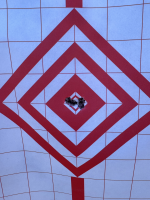
Last edited:
You need to try a little harder than that. You've effectively come in here telling everyone gender is a social construct.
You can believe whatever you want to believe. But believing in something is different than being right about it.
My wife thinks ghosts are real and watches those stupid ghost-hunting shows even though she knows I grew up with one of the producers of the most popular one and I know for a fact it's all BS.
Do what you want, just don't try and tell me water ain't wet.
I'm merely someone bringing facts to a fiction party.
If you have a powder dropper capable of +/- 0.02gn consistency, feel free to fact-check me.
Be a better ammo factory, that's all it is. Today's rifle barrels are made on machines with +/- 0.0005" tolerance or better. There's no need to load-develop shit if you can make consistent rounds over and over again (and for me doing that means it takes annealing every firing and a mandrel lol).
Maybe you don't believe me because you suck at reloading? Occam's Razor is usually right after all.
As an aside, these are 2 different 5-shot groups at 100 yards I shot back to back while zeroing my gun the other day... I shot the first group and then adjusted the windage a tenth right and shot another. I'm currently running a Razor Gen3 which allows for zeroing between any clicks, so I adjusted it back a half of a tenth between the lines and left it there. I noticed later that both groups were one hole. I pulled the load out of thin air, just picked a speed, just picked a seating depth, no load development whatsoever (and I don't believe in coincidence or luck):
View attachment 8520250
Get the fuck outta here talking about precision and you show up with a 100 yard target.
Well geez, some cheery picked groups on steel are sure proof your ammo could hang with top fclass and BR shooters.
Like the poster child for Dunning-Kruger.
I would consider that load development.There are known things that work, that guys figure out quickly, like if you send a 6mm 105-115gn projectile out of a 1 in 7.5 twist barrel at ~2750-2950fps it'll probably shoot if one can control enough variables to maintain low SD and ES numbers... but beyond that, it's all pseudo-science and nonsense.
Control what you can control and don't waste your time chasing your tail, just try to get something repeatable, repeatable is good since a "bad load" that prints the same way every time isn't a bad load at all, it's cause and effect, and we can work with that.
Nice shooting - All would be terrible benchrest groups though and no where near enough to even talk f class. You should actually go check out a benchrest match sometime instead of lying to us about it. You might be impressed and will definitely learn something about the benefits of load development
I'll agree with @CK1.0 on this topic.
I have tried many different methods over the last 32 years that I have been handloading and have come to the conclusion that I have wasted a lot of components and gas trying to find the "Best Load".
To start off with, I'll measure the distance at which the bullet is up against the lands and reduce that by .055" to start for my seating depth. If there is pressure test data for the cartridge I am using, I will look where the min and max are and load up quarter or half grain steps between those two points usually in samples of three cartridges each. I'll shoot these at 100 yards while recording velocity. This is all assuming we are shooting a cartridge that uses around 30-40 grains of powder.
If the barrel is meant for PRS use, I will pick a load on the slower end that both grouped well and had velocity numbers that were not wild. I'll shoot that for the first 200 rounds or so until it looks like the velocity has stabilized. Then I will retest using nearly the same method but choosing the velocity window I am looking for. I'll load these in .25 grain steps and samples of three and again pick the best two or three groups with good velocity SD/ES numbers. I'll take those two or three loads to my long distance range and shoot them in groups of 10 at 700 and pick the best performer.
When I started loading my most recent barrel chambered in 25GT I knew I wanted to use N150 powder. Had I not been comparing 135 hybrids and 134 ELD's I would have had a start load determined in 20 rounds fired, 5 of which were to season the bore and get a rough zero. After 75 rounds of practice drills over a couple days I used it at a one day regional which put another 110 rounds through the bore. I retested powder weights again between 2590fps and what I figured would be about 70 fps faster and tested those five samples (15 rounds) where three samples shot well and I retested those at 700. So, 60 test rounds altogether of actual "Load Development" were used.
Never touched the seating depth. Will it win a bench rest match? No, probably not. Will it hold under half moa at distance more often than not and bring PRS trophies home? Yes!
I have tried many different methods over the last 32 years that I have been handloading and have come to the conclusion that I have wasted a lot of components and gas trying to find the "Best Load".
To start off with, I'll measure the distance at which the bullet is up against the lands and reduce that by .055" to start for my seating depth. If there is pressure test data for the cartridge I am using, I will look where the min and max are and load up quarter or half grain steps between those two points usually in samples of three cartridges each. I'll shoot these at 100 yards while recording velocity. This is all assuming we are shooting a cartridge that uses around 30-40 grains of powder.
If the barrel is meant for PRS use, I will pick a load on the slower end that both grouped well and had velocity numbers that were not wild. I'll shoot that for the first 200 rounds or so until it looks like the velocity has stabilized. Then I will retest using nearly the same method but choosing the velocity window I am looking for. I'll load these in .25 grain steps and samples of three and again pick the best two or three groups with good velocity SD/ES numbers. I'll take those two or three loads to my long distance range and shoot them in groups of 10 at 700 and pick the best performer.
When I started loading my most recent barrel chambered in 25GT I knew I wanted to use N150 powder. Had I not been comparing 135 hybrids and 134 ELD's I would have had a start load determined in 20 rounds fired, 5 of which were to season the bore and get a rough zero. After 75 rounds of practice drills over a couple days I used it at a one day regional which put another 110 rounds through the bore. I retested powder weights again between 2590fps and what I figured would be about 70 fps faster and tested those five samples (15 rounds) where three samples shot well and I retested those at 700. So, 60 test rounds altogether of actual "Load Development" were used.
Never touched the seating depth. Will it win a bench rest match? No, probably not. Will it hold under half moa at distance more often than not and bring PRS trophies home? Yes!
I'll agree with @CK1.0 on this topic.
I have tried many different methods over the last 32 years that I have been handloading and have come to the conclusion that I have wasted a lot of components and gas trying to find the "Best Load".
To start off with, I'll measure the distance at which the bullet is up against the lands and reduce that by .055" to start for my seating depth. If there is pressure test data for the cartridge I am using, I will look where the min and max are and load up quarter or half grain steps between those two points usually in samples of three cartridges each. I'll shoot these at 100 yards while recording velocity. This is all assuming we are shooting a cartridge that uses around 30-40 grains of powder.
If the barrel is meant for PRS use, I will pick a load on the slower end that both grouped well and had velocity numbers that were not wild. I'll shoot that for the first 200 rounds or so until it looks like the velocity has stabilized. Then I will retest using nearly the same method but choosing the velocity window I am looking for. I'll load these in .25 grain steps and samples of three and again pick the best two or three groups with good velocity SD/ES numbers. I'll take those two or three loads to my long distance range and shoot them in groups of 10 at 700 and pick the best performer.
When I started loading my most recent barrel chambered in 25GT I knew I wanted to use N150 powder. Had I not been comparing 135 hybrids and 134 ELD's I would have had a start load determined in 20 rounds fired, 5 of which were to season the bore and get a rough zero. After 75 rounds of practice drills over a couple days I used it at a one day regional which put another 110 rounds through the bore. I retested powder weights again between 2590fps and what I figured would be about 70 fps faster and tested those five samples (15 rounds) where three samples shot well and I retested those at 700. So, 60 test rounds altogether of actual "Load Development" were used.
Never touched the seating depth. Will it win a bench rest match? No, probably not. Will it hold under half moa at distance more often than not and bring PRS trophies home? Yes!
Claiming you don’t need to load develop to shoot good ammo and claiming it’s worthless voodoo are two completely different things.
Sounds like you agree with the first like we all do.
You can't possibly dispute that there are some powder/bullet combinations that work better for a particular rifle than others. So why is that?Apparently I’m an idiot. Load development is a crock of shit.
I pick a speed, pick a BTO length, drop every charge to the nearest kernel, and magically it works every single time with every new barrel.
You fudds can keep driving back and forth to the range burning up all your components 5-shot group after 5-shot group if you want, but you’re just performing a Rorschach test on yourself until you see what you want to see.
You absolutely CAN have one bullet shoot like shit with powder A, but group much better with powder B. I think this is what @Ledzep generally focuses on as the biggest bang-for-buck based on his posts. So the burn characteristics of the propellant matters a lot.
If the pressure curve created by a specific powder can significantly impact precision, then the specific charge of powder (or seating depth or any other variable that influences that pressure curve) is also extremely likely to make some impact on precision. The question is how much.
I think what we've learned as of late is that its unlikely you will take a 3 moa bullet/powder combo and make it a 0.5 moa combo by finding the "right load." However, I think you absolutely can take a 1.0 moa combo and make it close to a 0.5 moa combo by finding the right load/seating depth.
Even if load development is only capable of improving precision from 1 moa to 0.5-0.6 moa, people spend shitloads of money on rifles to attempt to make that leap. Burning up 150 rounds of testing to find it pales in comparison.
You can't possibly dispute that there are some powder/bullet combinations that work better for a particular rifle than others. So why is that?
You absolutely CAN have one bullet shoot like shit with powder A, but group much better with powder B. I think this is what @Ledzep generally focuses on as the biggest bang-for-buck based on his posts. So the burn characteristics of the propellant matters a lot.
If the pressure curve created by a specific powder can significantly impact precision, then the specific charge of powder (or seating depth or any other variable that influences that pressure curve) is also extremely likely to make some impact on precision. The question is how much.
I think what we've learned as of late is that its unlikely you will take a 3 moa bullet/powder combo and make it a 0.5 moa combo by finding the "right load." However, I think you absolutely can take a 1.0 moa combo and make it close to a 0.5 moa combo by finding the right load/seating depth.
Even if load development is only capable of improving precision from 1 moa to 0.5-0.6 moa, people spend shitloads of money on rifles to attempt to make that leap. Burning up 150 rounds of testing to find it pales in comparison.
He used the load development of other people that is known to shoot well to justify his belief that load development is a myth.
Talking about this is the same as talking about religion… and no matter what is said or what facts are brought to the table, some people are just going to believe what they choose to believe.
It’s your components and your barrel life, so do as you want, but 9 times out of 10 the difference between a “good load” and a “bad load” has more to do with the monkey pulling the trigger than anything else.
It’s your components and your barrel life, so do as you want, but 9 times out of 10 the difference between a “good load” and a “bad load” has more to do with the monkey pulling the trigger than anything else.
These are always fun...
Anyways, here are some of my personal thoughts.
When it comes to reloading, the most important thing is consistency. Use projectiles that your barrel likes. Use high quality components when possible (like brass and projectiles). I'm personally not convinced that minute changes will make big differences - changing a bullet seating depth by 3 thou or a powder charge by a couple of tenths is not really going to move the needle. However, there are some combinations that work better than others, and I think that comes down to using appropriate powder, appropriate fill/charge weight and the appropriate projectile.
I think its worth testing out different components to see what your rifle likes. Projectiles, powders, primers, etc. There are some combinations that are just proven to work that doesn't require exploration - like H4350 powder in 6.5 Creedmoor. I can give you some recipes for 6.5 Creedmoor and 6BRA that will most certainly work in anyone else's rifles - its not magic.
How you reload matters. What components you use matter. Trying to find "nodes" in which there's this magical spot that your ammo performs much better than being another thou or two on either side of that is fanciful thinking.
I think many reloaders get stuck on the minutia, where they try to make conclusions that don't actually exist using inadequate tests. There's some pretty extravagant ideas in the reloading world, where merely moving the bullet seating depth by a thousandth may place you in this perfect "node" that is optimal for your barrels harmonics.
Instead, I think 98% of making good reloads comes down to being consistent and using combinations/recipes that just happen to work. And I think that's more a function of powder burn and pressure than anything to do with barrel harmonics.
Anyways, here are some of my personal thoughts.
When it comes to reloading, the most important thing is consistency. Use projectiles that your barrel likes. Use high quality components when possible (like brass and projectiles). I'm personally not convinced that minute changes will make big differences - changing a bullet seating depth by 3 thou or a powder charge by a couple of tenths is not really going to move the needle. However, there are some combinations that work better than others, and I think that comes down to using appropriate powder, appropriate fill/charge weight and the appropriate projectile.
I think its worth testing out different components to see what your rifle likes. Projectiles, powders, primers, etc. There are some combinations that are just proven to work that doesn't require exploration - like H4350 powder in 6.5 Creedmoor. I can give you some recipes for 6.5 Creedmoor and 6BRA that will most certainly work in anyone else's rifles - its not magic.
How you reload matters. What components you use matter. Trying to find "nodes" in which there's this magical spot that your ammo performs much better than being another thou or two on either side of that is fanciful thinking.
I think many reloaders get stuck on the minutia, where they try to make conclusions that don't actually exist using inadequate tests. There's some pretty extravagant ideas in the reloading world, where merely moving the bullet seating depth by a thousandth may place you in this perfect "node" that is optimal for your barrels harmonics.
Instead, I think 98% of making good reloads comes down to being consistent and using combinations/recipes that just happen to work. And I think that's more a function of powder burn and pressure than anything to do with barrel harmonics.
He used the load development of other people that is known to shoot well to justify his belief that load development is a myth.
That's one way to interpret it...
First off, I didn't say that load development is a myth. I said that the methods that most people have been traditionally using aren't statistically viable for exposing the performance differences between loads to the level that people like to (or believe they are) AND that when you do conduct statistically relevant tests, the differences in performance and their corresponding hit probabilities down-range are very often not as dramatically different as many people believe. I have also tried to convey the order of influence of various load development parameters. I think the biggest thing I've tried to convey is that 3-5 shot groups love to lead you astray and give false confidence in the system in zero, dispersion, and MV spreads. Whether that's applicable to your purposes or not isn't my business. I'm just offering the perspective.
I did a series of complete load developments with charge weight ladders of as many applicable powders as I could find for several cartridges with several bullets, then did several seating depths of the best loads. Then tested several of the best performing loads in different barrels. Then I looked at the pile of data I had created by burning out a few accuracy test barrels in a purpose-built indoor climate controlled accuracy tunnel.
Generally speaking, my best shooting loads correspond with some of the more popular combinations that are out there. That's not a shocking surprise. However, there are plenty of exceptions because different barrels respond differently and the "Go-to" combinations don't always work in every barrel. Load development is definitely worth your time to explore if you're reloading for precision. Satterlee tests, 3-5-shot OCW, Ladder tests, etc... are not effective.
I do a coarse powder, seating depth, refine the powder and confirm.
^ This, but I do a coarse seating depth, then powder, refine and confirm at least twice.
I am a hobbiest who shoots out of my shop and off my back porch most of the time. Therefore it isn't detrimental to me (other than component cost) to tinker a little more to see if I'm getting a 95%+ solution.
She would have to be delusional to hang around your lying ass, even if she is yer sisterYou can believe whatever you want to believe. But believing in something is different than being right about it.
My wife thinks ghosts are real and watches those stupid ghost-hunting shows even though she knows I grew up with one of the producers of the most popular one and I know for a fact it's all BS.
Do what you want, just don't try and tell me water ain't wet.
Face it, there are probably more guys involved in this shit driving back and forth to the range doing "load development" and buying shit every other week that they hope will make them better, than guys doing any real work on their technique. This is backed up nearly every weekend with many guys finishing first in matches due to their skill instead of how great their ammo was.
For lots of guys, "load development" is the hobby, and what they do and all they do. Not a single snide comment has brought any evidence to the discussion to dissuade me from the opinion that it's generally a waste of time.
If you're one of those guys bringing an arbor press to the range, loading up a few rounds here, and a few rounds there, and "testing" all the time, it's arguable whether you're even doing the same thing as the rest of us who're working on getting better at shooting better.
Of course, there are known "recipes" that will get you in the ballpark that I, like many, use. But that's not load development, that's good practice, as none of us have degrees in combustion, and for the most part, we're all winging it.
I have my own theories too. Like, in general, I like to use the best combos that tend to result in low SD and ES numbers like using the fastest powders you can get away with (probably why Varget is always one of the first ones sold-out), but thinking a few thou of seating depth or going up or down a few tenths of a grain in charge weight is going to miraculously make things amazing is just plain crazy. But, it sure seems like a good way to sell a bunch of tuners and other nonsense lol.
Looking to those who work for a bullet manufacturer as experts and taking what they say as gospel is ridiculous too as they're just talking heads who haven't proven or won anything, and it's not in their economic interest to tell you it's a waste of time so why would they spill the beans?
A guy like Austin Buschman has won just about everything and has been using the same load recipes for literally years, with more different barrels than most of those reading this will ever burn out in their lifetimes... so if you're calling me an idiot then you're calling guys like him an idiot too, and no matter how much load development you do guys like him will still beat your asses until you work on getting better at shooting instead of focusing on never ending load development.
For lots of guys, "load development" is the hobby, and what they do and all they do. Not a single snide comment has brought any evidence to the discussion to dissuade me from the opinion that it's generally a waste of time.
If you're one of those guys bringing an arbor press to the range, loading up a few rounds here, and a few rounds there, and "testing" all the time, it's arguable whether you're even doing the same thing as the rest of us who're working on getting better at shooting better.
Of course, there are known "recipes" that will get you in the ballpark that I, like many, use. But that's not load development, that's good practice, as none of us have degrees in combustion, and for the most part, we're all winging it.
I have my own theories too. Like, in general, I like to use the best combos that tend to result in low SD and ES numbers like using the fastest powders you can get away with (probably why Varget is always one of the first ones sold-out), but thinking a few thou of seating depth or going up or down a few tenths of a grain in charge weight is going to miraculously make things amazing is just plain crazy. But, it sure seems like a good way to sell a bunch of tuners and other nonsense lol.
Looking to those who work for a bullet manufacturer as experts and taking what they say as gospel is ridiculous too as they're just talking heads who haven't proven or won anything, and it's not in their economic interest to tell you it's a waste of time so why would they spill the beans?
A guy like Austin Buschman has won just about everything and has been using the same load recipes for literally years, with more different barrels than most of those reading this will ever burn out in their lifetimes... so if you're calling me an idiot then you're calling guys like him an idiot too, and no matter how much load development you do guys like him will still beat your asses until you work on getting better at shooting instead of focusing on never ending load development.
Last edited:
Holy fucking shit! I can't believe all the arguing back and forth. Do or do not. What the actual fuck? @spife7980 just for fun here.
I will include here a set that I did with a 223 Ackley. I shot 10 groups of 10 seating depth changes after finding my max pressure (not velocity but they are hand in hand) with bullet against the lands. All same charge measured to the kernel with my FX120i scale and auto trickler but finished by hand with a hand trickler.
You see that at touching, I was roughly 1 MOA low, a 1.5MOA group of 10. I meant to dial my scope, just because, but forgot until I shot the first round at -0.001" seating depth, about 1 MOA 9 shot group. I adjusted the scope. At -0.007" there is a flyer that I called. That one is 100% me. Still, group is now about 1 MOA.
There was a slight right to left wind, maybe 3 mph, a few gusts higher, that accounts very slightly for the horizontal stringing.
What seating depth would you choose as being mo betta or are they all good to go?


Edit to say: These groups were fired 45 minutes apart with a thorough cleaning of the rifle after each group of 10. I shot LOTS of 22LR in my Bergara figuring out what it liked on this same day. I also did some verifying with one of my 300 WINMAGS. I wasn't just sitting there waiting for my timer to ding.
I will include here a set that I did with a 223 Ackley. I shot 10 groups of 10 seating depth changes after finding my max pressure (not velocity but they are hand in hand) with bullet against the lands. All same charge measured to the kernel with my FX120i scale and auto trickler but finished by hand with a hand trickler.
You see that at touching, I was roughly 1 MOA low, a 1.5MOA group of 10. I meant to dial my scope, just because, but forgot until I shot the first round at -0.001" seating depth, about 1 MOA 9 shot group. I adjusted the scope. At -0.007" there is a flyer that I called. That one is 100% me. Still, group is now about 1 MOA.
There was a slight right to left wind, maybe 3 mph, a few gusts higher, that accounts very slightly for the horizontal stringing.
What seating depth would you choose as being mo betta or are they all good to go?
Edit to say: These groups were fired 45 minutes apart with a thorough cleaning of the rifle after each group of 10. I shot LOTS of 22LR in my Bergara figuring out what it liked on this same day. I also did some verifying with one of my 300 WINMAGS. I wasn't just sitting there waiting for my timer to ding.
Last edited:
Similar threads
- Replies
- 23
- Views
- 1K
- Replies
- 17
- Views
- 423
- Replies
- 19
- Views
- 1K
